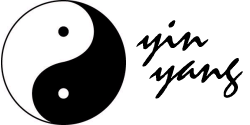West Meets East: Yin/Yang
I am perennially interested in what I prefer to call things unseen: spirituality, theology, psychology, the great mysteries associated with human existence. I know something about Judaism and Christianity, but I am also interested in Eastern religious and philosophical systems.
I am very much a Westerner in my thought processes, and I struggle to grasp Eastern ideas. Recently, I've been doing a little research on yin/yang. What follows is a summary of information gleaned from several Web sites, and then a few observations of my own.
Introductory concepts
According to the ancient Chinese philosophy, Tai Chi, yin and yang are the elemental principles of the cosmos. Though they are opposites, they complement one another to form a single whole. Together, yin and yang generate everything that exists. Every person and thing is governed by the continuous interaction between them.Neither is good or bad. Though they appear to be opposites, each exists only by virtue of the other. Though we can distinguish between them, they are inseparable.
“Yang” means “the sunny side of the hill”; it corresponds to the day and more active functions. “Yin” means “the shady side of the hill”; it corresponds to night and less active functions.
The yin/yang symbol:
(aka the Tai Chi symbol)
- Within each colour there is a dot of the opposing colour.
- The dots signify that every phenomenon contains within itself the seed of its opposite state, though it may be unseen.
- The dividing line between the two sectors is curved.
- The curved line denotes movement and a constant flowing of yin into yang and yang into yin. It signifies that all phenomena change into their opposites in an eternal cycle.
- When yin has reached fullness, it recedes in favour of yang; when yang has reached fullness, it recedes in favour of yin. They can consume one another: extreme yin (water) can extinguish yang (fire); extreme yang (heat) can cause yin (water) to evaporate. Neither principle continually dominates the other or determines the other.
- The two colours are in equal proportion, evenly balanced.
- The balanced proportions depict an ideal state. To increase one sector would necessitate decreasing the other. Every phenomenon or state that we experience (poverty/abundance, sickness/health, power/weakness, etc.) results from the transient precedence of one principle over the other.
- Theoretically, the ideal state is an appropriate balance of yin and yang. This is not to say that everyone should have exactly half of each. Each of us needs to find a balance appropriate to our own constitution, climate, season, occupation and even emotional environment. In reality, yin and yang never exist in a static, 50:50 balance.
Further details
When the cosmos was taking shape, the quality of yang was more rarefied and vast. It therefore floated upwards to form the Heavens. Yin was more condensed. It sank down and created Earth.Yin and yang are always spoken of in relative terms. Something can be yin in relation to a second thing but yang in relation to a third. For example, Earth is yin in relation to the sun but yang in relation to the moon.
Any yin or yang aspect can be further subdivided into finer gradations of yin and yang. For example, temperature: hot (yang) can be further divided into warm (yin) or burning (yang). Likewise, cold (yin) can be further divided into cool (yang) or icy (yin).
| Yang | Yin |
|---|---|
| day, light | dark, night |
| fire | water |
| heat | cold |
| south, east | north, west |
| left, up | right, down |
| intellect | intuition |
| active, dynamic | passive, static |
| innovative, reformative | conservative, traditional |
| mountain | valley |
| desert | river |
| hard | soft |
| physical (observable) world | psychological (astral) world |
Questions
(1) I know I'm hopelessly captive to the canons of Western logic, but how can a thing become its opposite? According to the Asian Art Mall, the interior dots signify "that each force contains the seed of the other, so that they do not merely replace each other but actually become the other." I understand that darkness succeeds light, and light succeeds darkness: but how can light become darkness, and vice versa?(2) According to Richard Hooker, "all opposites that one experiences—health and sickness, wealth and poverty, power and submission—can be explained in reference to the temporary dominance of one principle over the other." Do all the positive phenomena (health, abundance, power) result when yang is dominant? Do all the negative phenomena (sickness, poverty, weakness) result when yin is dominant? If so, why isn't it accurate to say that yang is good and yin is bad?
Other sources include: Ray Wood; Wikipedia; and Yin yang house.


0 Comments:
Post a Comment
<< Home